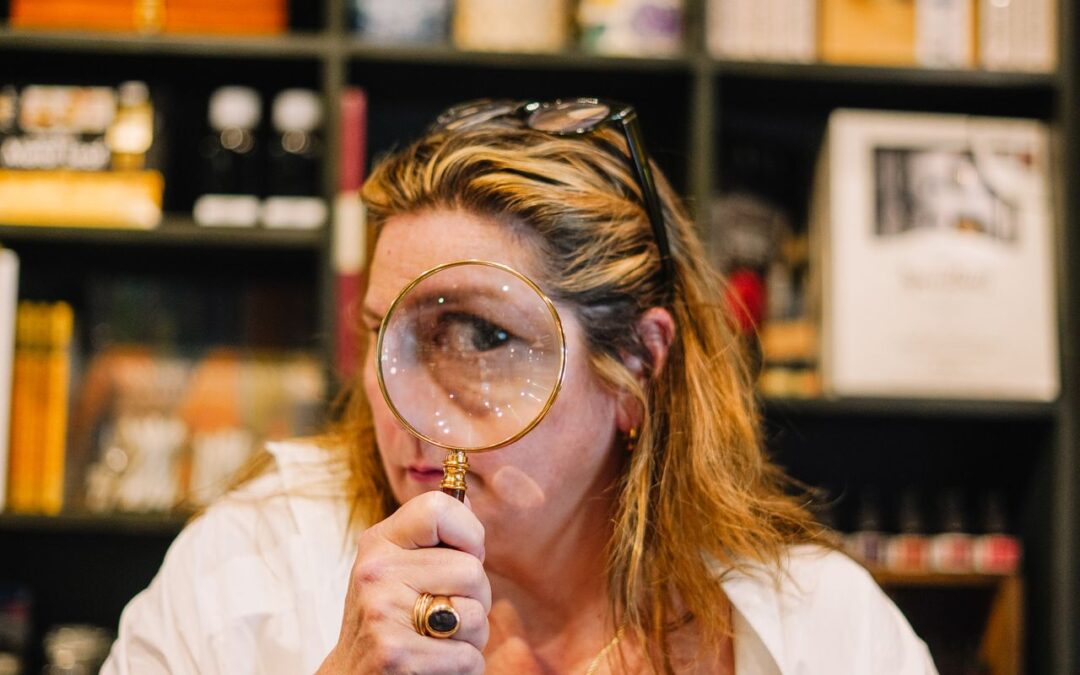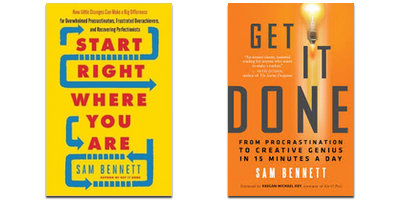
Hi! –
You matter to me.
Your work matters to me.
The world needs you.
The world needs your work.
You were made to make things.
You are happiest when you make things.
No one can stop you from making things.
Not even you, no matter how hard you try sometimes.
Relent in the face of your relentless desire to create.
Give in to your desire to give.
Share your need to share.
You don’t need to know how to start.
Just start.
All we have to leave behind when we go
are things we make
and the love we’ve shared.
We need you now.
Yours,
Sam
By the Way, You Look Really Great Today

Hi –
“If my work could just help ONE person….it would be worth it.”
I hear this a lot.
I’ve even said it.
And you know what?
It’s true.
I got this email the other day, and have been swooning with joy ever since:
***********
Hello Sam!
THANK YOU! THANK YOU! THANK YOU!
I appreciate that you likely receive hundreds of emails per day and may never read this one but I feel compelled to use my 15 minutes (actually 30+ minutes) today to express my immeasurable gratitude for your book and story.
I have a quirky, eclectic, integrative, holistic psychiatry practice consisting of many ADHD adults, myself included.
I do a lot of therapy and coaching with my patients and I love to provide pertinent reading recommendations that will help them get things done.
Your book will now be mandatory reading/ listening for many of my procrastinating patients whom I love dearly. (I will likely recommend the audio version because hearing it read is simply GOLD!)
I loved the short, easy to digest chapters with the consistent lay-out of the 90 second doodle, 15 minute experiment, and the hopeful “What If?” (I have yet to do the doodles but I have made a doodle of my goldendoodle. Does that count?)
I loved that this well-crafted gem is practical, yet sneaks in a lot of deep, inner work in a fun, witty, real, authentic, gentle, and compassionate way using many of my favorite authors and techniques. BRILLIANT.
I loved that you shared your struggle with Long C0vid, yet, managed to write this book using your own method. INSPIRING TESTIMONIAL….
I loved that you shared so many emotionally vulnerable moments, giving others permission to have and accept their emotional moments as a normal part of the human condition. Humans need more skills with managing their emotions.
I would gladly continue this praise parade, but alas, my Quickbooks awaits. (Thanks for the stats on female-owned businesses. I have had my meager business since 2003 and rarely give myself credit that it has lasted this long.)
Thanks, again, for your amazingly transformative book.
– Diane C. Berie, M.D., ABIHM
(lightly edited and shared with permission; emphasis mine)
************************
First of all, it does my heart good to know that there are gifted healers like Diane in the world, helping the neurospicy population evolve, grow, and succeed.
And I love that she took the time to write such a thoughtful email.
What a meaningful gift she gave me.
I share this with you for THREE important reasons:
1) If there is a writer you love, please let them know. Leaving a review is priceless. Writing an email is an especially nice gesture. Everyone needs to hear that their work matters, no matter how long they’ve been doing it or how “successful” they are, right?
2) If you haven’t reviewed your own testimonials lately, do your poor bruised ego a favor and re-read them right now. Keep them nearby, so that if you ever catch yourself despairing whether or not your work makes a difference, you can see the evidence that it sure as f*ck does.
Thank you from the bottom of my scribbling author’s heart.
Yours,
Sam
P.S. And if you’ve been putting off writing your own book because you’re not sure anyone would care — please take this as your sign that your words are both needed and necessary — and your time to start writing in earnest is NOW.
By the Way, You Look Really Great Today

Well this completely made my day….
And I thought it might lift you all up, too
xo
s
“Hello Sam!
I just finished listening to “The 15-Minute Method” on Spotify.
THANK YOU! THANK YOU! THANK YOU!
I appreciate that you likely receive hundreds of emails per day and may never read this one but I feel compelled to use my 15 minutes (actually 30+ minutes) today to express my immeasurable gratitude for your book and story.
I have a quirky, eclectic, integrative, holistic psychiatry practice consisting of many ADHD adults, myself included.
I do a lot of therapy and coaching with my patients and I love to provide pertinent reading recommendations that will help them get things done.
Your book will now be mandatory reading/ listening for many of my procrastinating patients whom I love dearly. (I will likely recommend the audio version because hearing it read is simply GOLD!)
I loved the short, easy to digest chapters with the consistent lay-out of the 90 second doodle, 15 minute experiment, and the hopeful “What If?” (I have yet to do the doodles but I have made a doodle of my goldendoodle. Does that count?)
I loved that this well-crafted gem is practical, yet sneaks in a lot of deep, inner work in a fun, witty, real, authentic, gentle, and compassionate way using many of my favorite authors and techniques. BRILLIANT.
I loved that you shared your struggle with Long Covid, yet, managed to write this book using your own method. INSPIRING TESTIMONIAL. I, too, have experienced debilitating fatigue from adrenal insufficiency, Lyme, mold, and opportunistic infections. It sucks. And, also, there have been gifts, silver linings, and accomplishments along the way.
I loved that you shared so many emotionally vulnerable moments, giving others permission to have and accept their emotional moments as a normal part of the human condition. Humans need more skills with managing their emotions.
I would gladly continue this praise parade, but alas, my Quickbooks awaits. (Thanks for the stats on female-owned businesses. I have had my meager business since 2003 and rarely give myself credit that it has lasted this long.)”

Hi!
Your Book: Hi.
You: Oh, it’s you again.
Your Book: I don’t want to bother you. I know you’re busy. But I CHOSE YOU. And I’m still hanging around waiting for your attention.
You: Why did you choose me??
Your Book: Because you have the exact perfect combination of life experience, insight, expertise, and curiosity to author me. You’re the only person I want to write me.
You: Seems like there are already books like you out there…
Your Book: Maybe – but they aren’t by you. You bring the magic.
You: I don’t think I’m magic….
Your Book: Only because you can’t see yourself the way I can. I can see the future you — the one who’s already written me — and you are positively bathed in magic.
Your magic brings about brave new changes and exciting challenges.
Your magic attracts the right people and good money.
Your magic heals others.
Your magic is a blessing to the world.
You: Wow. OK. Thanks.
Your Book: So will you write me?
You: Um…..I’m very busy….
Your Book: How about 15 minutes a day? Could you write that much?
You: I guess, but….
Your Book: If you write 15 minutes a day for 6 months, that’s about 42,000 words. Which is a book.
You: But what about all the other stuff — How to get published? Do I need an agent? Is it worth all the effort? How do I get people to buy it? Is my ttitle any good? And worst of all: what if I’m writing the wrong book????
Your Book: For that you need expert advice like from Allison Lane and Sam in the Super Secret Book Writing Club.
You: Great idea…
Your Book: Get your seat now — they start live tomorrow, OK?
You: OK, but….What if it doesn’t work?
Your Book: No creative effort is ever wasted. No education is ever wasted. No commitment to your true self is ever wasted.
You: Ohhhhh….that’s true.
Your Book: Plus, they say “Satisfaction Guaranteed or Your Tuition Cheerfully Refunded,” so I think you’re in good hands.
You: OK! I’m trusting you!
Your Book: I’m trusting you right back, my love.
Let’s Do This Thing
Yours,
Sam

Hi!
Did you know that most authors earn less than $2000 from their book??
Let’s put a stop to that silliness, shall we?
And let’s do it NOW – before your book is even written!
(This also works if your book is done, obvs.)
Join me for:
7 1/2 Ways to Make $5k from Your Book Before It’s Even Written
Friday, Sept. 26
7am PT / 10am ET / 3pm BST
90 minutes
Cameras on, please
Just $646 $97
Satisfaction Guaranteed or Your Tuition Cheerfully Refunded
—> CLICK HERE to get your seat now
This is an ALL NEW step-by-step workshop taking you through ways you can profit from your creativity that are:
- FUN
- CLEVER
- UNUSUAL
- EASY TO DO
- REQUIRE NO SPECIAL TECH
And I bet you’ve never even thought of at least 4 of them : )
Let’s make writing your book a completely worthwhile experience.
Any questions, just write me back. I love to hear from you.
Yours,
Sam

Dearest readers –
In case you hadn’t realized, the world is in desperate need of you.
More specifically, we need your story.
The only thing that ever changed the world is a new story.**
YOUR BOOK – NOW – in this time of confusion and unrest – brings hope, understanding, comfort, insight, a good laugh, a good recipe, and the stories that are a reminder of our shared humanity.
Nothing is more important than your book.
And you know that if you don’t invest time and money into it, it won’t get done, right?
Super Secret Book Writing Club is populated by writers at all levels:
– one person has “just a concept”
– one person is an award-winning Hollywood screenwriter
– one person has a manuscript completed, but needs a platform
– one person is a university professor, ready to break free of academic writing
– one person is 86-years old (if she can do it – you can do it)
And EVERYONE has a different topic and style of book:
– a YA fantasy book
– a business success book for women
– a memoir of love and loss
– a ripped-from-the-headlines roman à clef
– “a few different ideas – still figuring it out”
And EVERYONE is dealing with “life stuff”:***
– a demanding full-time job
– the drain of chronic health issues
– the distress of caring for aging parents
– the juggling act of caring for growing kids
– intense financial issues
And EVERYONE is dealing with self-doubt:
– is it good enough?
– will anyone care?
– am I getting too big for my britches?
– what if it doesn’t work?
– what if I fail?
And EVERYONE has questions about the path forward:
– what publishing path should I take?
– is hybrid publishing for real?
– how do I handle marketing when I hate marketing?
– do I need a platform?
– how do I get an agent?






